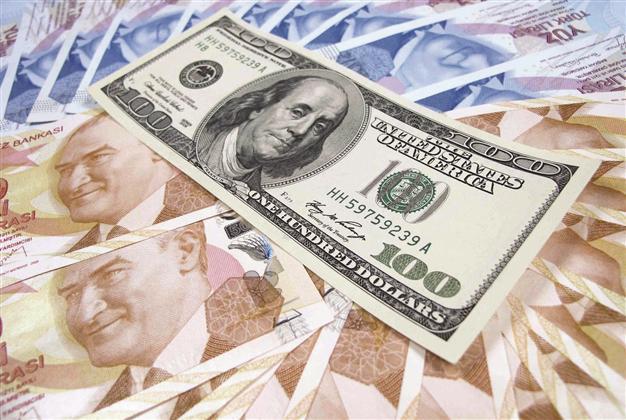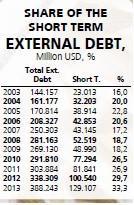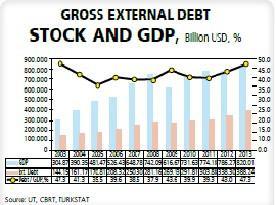Turkey’s foreign debt surpasses 47 percent of national income
Mustafa SÖNMEZ - mustafasnmz@hotmail.com

Even though the loans to IMF have all been paid, the state owes $120 billion to other international institutions and markets.
When Turkey’s 2013 growth external debt stock data was released last week, the dimensions and the content of the external debt stock, which is the main wind behind growth, were made clear. The growth rate for 2013 for the Turkish economy has been 4 percent, thus above the 2.1 growth of 2012.
However, when the growth rate of an average of 9 percent in the years 2010 and 2011 are reminded, even if this figure is above the one of 2012, it is still named as “stalling growth.”
It was seen that the 4 percent growth of 2013 was predominantly stemming from domestic consumption and that the contribution of foreign trade to growth has been very weak.
While the annual increase in private consumption reached 4.6 percent, it was also the public expenditures and public investments that were effective in growth.
Public consumption expenditures increased nearly 6 percent in 2013. The increase in private sector investments has been close to zero and did not affect growth.
Growth per capita When the national income of 2013 is expressed in U.S. dollars, the national income of 2013 reached $820 billion. This is the indicator that makes Turkey the 16th or 17th largest economy of the world.
When it is divided into the population, the per capita income has become $10,782. This figure was

$10,459 in 2012.
Usage of external loans or the external debt stock, which is the main wind behind growth, was released by the Office of the Treasury Undersecretary. The external debt stock reached at the last quarter of 2013 has become $388.2 billion.
During the Justice and Development Party (AKP) rule, external debts increased nearly 11 percent each year and in 2013, this figure has neared 15 percent. In just 2013, Turkey’s foreign debt burden increased by $50 billion.
With Turkey’s external debt stock reaching $388 billion, its ratio to the national income, which was released as $820 billion, has exceeded 47 percent. In 2012, the ratio of external debt stock to the national income was 43 percent.
While in those years when the dollar exchange rate was following a low course because national income seemed high when expressed in dollars, this ratio was below 40 percent.

In the first year of the AKP era, the external debt stock was $144 billion and this figure jumped up to $388 billion in 2013, increasing nearly 170 percent. In the same era, the national income’s expression in dollars also increased in the same rate. The economy grew with the supply of external debts.
In 2013, the current accounts deficit neared $66 billion and this corresponded to 8 percent of the national income, which was announced as $820 billion. This is the highest current account deficit to the GDP rate among g-20 countries and looks as if it is the most important source used in the financing of the external debt.
Short term
It is important and critical that the $388 billion’s external debt burden of 2013 is short term at a rate of one third. In 2003, the $23 billion of short term loans made up 16 percent of the total external debt stock. In the following years with more usage of short term loans, the rate of short term has increased and reached 33.3 percent in 2013, corresponding to $129 billion. It is observed that especially in 2013, short term loans recorded a considerable hike and $30 billion of the 50 billion external debts found were short term. This is an indicator of the difficulty faced in finding external loans.

The external debt stock data as of the end of 2013 shows the debt burden of the private sector is close to 69 percent of the total. At the beginning of the AKP era, public debts were predominant with 66 percent, with borrowing from the IMF being the forefront. In following years, with the tightening of the budget and the lowering of the need of debt of the public sector, public debts remained at a share of one third in the total, it was seen that the private sector took loans rapidly and made its share reach nearly $267 billion in 2013.
Even though the IMF debts were paid last year, the public still has $120 billion of external debt. The World Bank, some international organizations and markets have loaned $120 billion to Turkey’s public agencies and 15 percent of them are short term.


 In the first year of the AKP era, the external debt stock was $144 billion and this figure jumped up to $388 billion in 2013, increasing nearly 170 percent. In the same era, the national income’s expression in dollars also increased in the same rate. The economy grew with the supply of external debts.
In the first year of the AKP era, the external debt stock was $144 billion and this figure jumped up to $388 billion in 2013, increasing nearly 170 percent. In the same era, the national income’s expression in dollars also increased in the same rate. The economy grew with the supply of external debts. 